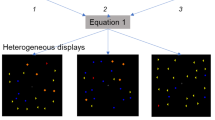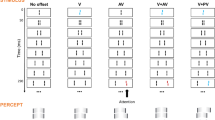Abstract
There is a wealth of anatomical1–4 and psychological5–9 evidence which suggests that when people look at an object in the visual world, its various attributes such as colour, 'form', motion and depth are analysed by separate channels in the visual system. If so, how are these attributes put back together again to create a unified picture of the object? And if the object moves rapidly, how is perfect perceptual synchrony maintained between different features on its surface, if it is indeed true that they are being processed separately? Our evidence suggests that the visual system extracts certain conspicuous image features based on luminance contrast, and that the signals derived from these are then attributed to other features on the object, a process that we call 'capture". Specifically, we find that when either illusory contours or random-dot patterns are moved in the vicinity of a colour-border, the colour border will also seem to move in the same direction even though it is physically stationary.
This is a preview of subscription content, access via your institution
Access options
Subscribe to this journal
Receive 51 print issues and online access
$199.00 per year
only $3.90 per issue
Buy this article
- Purchase on Springer Link
- Instant access to full article PDF
Prices may be subject to local taxes which are calculated during checkout
Similar content being viewed by others
Author information
Authors and Affiliations
Rights and permissions
About this article
Cite this article
Ramachandran, V. Interaction between colour and motion in human vision. Nature 328, 645–647 (1987). https://doi.org/10.1038/328645a0
Received:
Accepted:
Issue Date:
DOI: https://doi.org/10.1038/328645a0
This article is cited by
-
Treadmill locomotion captures visual perception of apparent motion
Experimental Brain Research (2008)
-
Motion distorts visual space: shifting the perceived position of remote stationary objects
Nature Neuroscience (2000)
-
Perceptual filling in of artificially induced scotomas in human vision
Nature (1991)
-
Fundamental properties of medical image perception
Journal of Digital Imaging (1991)
-
Revealing the artist's touch
Nature (1988)
Comments
By submitting a comment you agree to abide by our Terms and Community Guidelines. If you find something abusive or that does not comply with our terms or guidelines please flag it as inappropriate.



